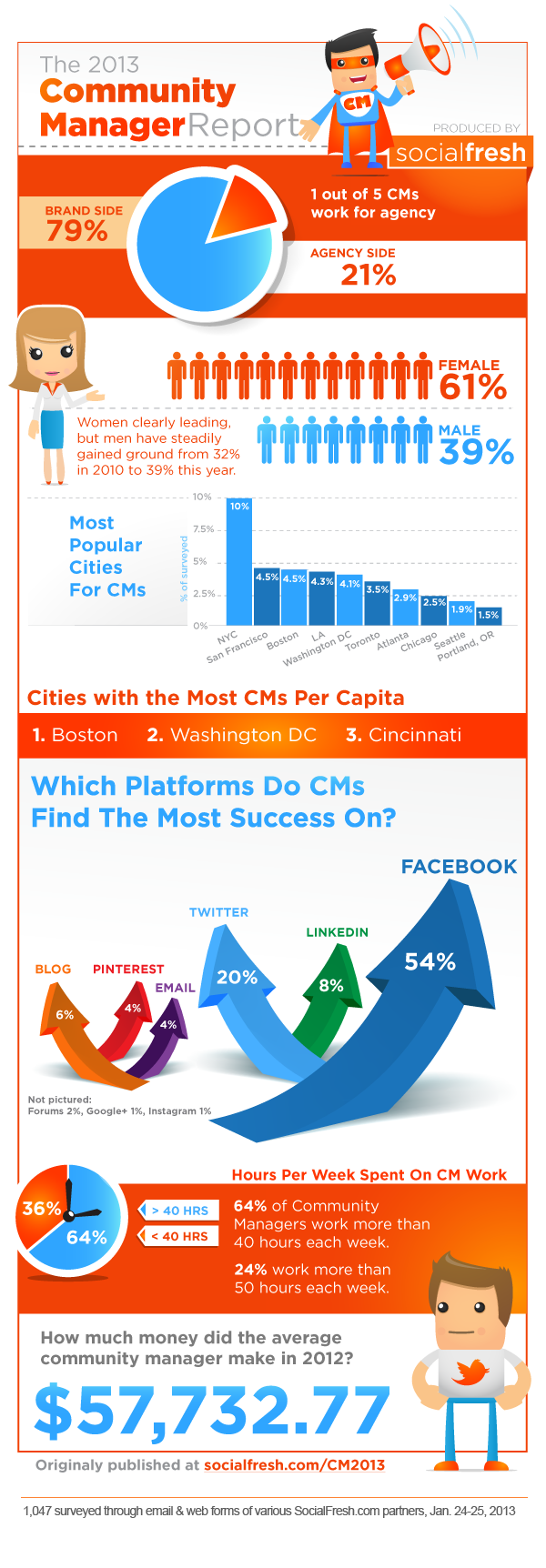In January, Social Fresh surveyed more than 1,000 partners for its annual Community Manager Report. It’s the third year Social Fresh has compiled the report. Some of the findings proved to be interesting (community managers trend female–in a male-dominated industry), while others really weren’t all that surprising (only 1 in 5 community managers is on the agency side). Shelly Kramer shared her two cents on the report here (and also congratulated friend Jeff Esposito of Vistaprint who recently won Community Manager of the Year–congrats Jeff!)
But, as I soaked in the data and really thought about it, a number of trends and predictions started to surface for me.
Here’s five community management trends I see playing out in the year ahead:
1-More brands are understanding they shouldn’t outsource community management
The early strategy for brands seemed to be to outsource community management to agencies. This is what we saw in the “early years” (and by “early” I mean 2008-2011 or so). We saw a lot of it–agencies just swooping in to take over community management of brand pages. It was an easy sell (freeing up brands to work on more strategic level work) and it was lucrative (bilable hours, remember?). But, brands are wising up–as evidenced by the fact that only 1 in 5 community managers now sit on the agency side of the table. Brands are starting to understand that it makes more sense to take this back in house. Ideally, that was always the case–but I think brands just wanted to take things slowly. Now, they’re better understanding the benefits of having this person in-house–more control, better understanding of the brand “voice”, and faster access to resources and answers.
2-Niche platforms will gain traction (where else to go but up?)
It’s not surprising that 54 percent of community managers are using Facebook as their primary platform. Or that Twitter came in second at 20 percent. What is surprising to me is how far back niche platforms like LinkedIn (8 percent), Pinterest (4 percent) and blogs (4 percent) were. Instagram and Google+ weren’t even on the list! This tells me that brands are really just focusing their time and energy on the “big two.” As they become more sophisticated, I think they’ll start siphoning off resources to community manage other platforms like Pinterest, Instagram, Google+ and others. After all, Pinterest is a web-traffic-driving machine, right? But, it also requires active management. As brands start to better understand these platforms, they’ll start devoting resources to them. Remember, it took them quite a while to take Facebook seriously–now they’re caught up. It’s going to take them a while to jump in and put more resources toward these other niche platforms–but I think 2013 is the year they start doing that.
3-Work/Life balance will NOT improve
According to the report, 64 percent of community managers work more than 40 hours a week. Actually seems a bit low to me as I’m guessing most people that work in social, in general, work far more than 40 hours a week. Just the nature of the business. But, I don’t see that number improving. In fact, I think it swings further the other way. Community managers will be asked to do more this year–not less. See my point above about niche networks. And, I don’t see brands adding a lot of social/community management staff just yet. They’ll want to see how their investment in social-specific staffing pans out first. Most brands are really just a couple years into this whole community management thing–they’re going to want to see if they’re really getting a return on that staffing investment. The result? Brands will start adding tasks to the community manager’s list. Sorry community managers–your job isn’t going to get any easier anytime soon.
4-A talent shortage will drive up community manager salaries
As the market matures (remember, the social industry has only been around for a handful of years), the people in these community management roles will command higher salaries. This is already happening. I hear from many friends in Minneapolis looking to hire social talent–and it’s simply not there right now. That’s a huge hole–and now brands are being forced to pay a premium for top talent. That will definitely result in higher community management salaries in 2013 and beyond. Plus, as community managers start to prove their worth, raises will soon follow. Also, the Dow topped 14,000 last Friday–as the economy grows and solidifies (fingers crossed), brands may loosen the salary purse strings a bit. All signs point to salaries increasing in the year ahead.
5-Senior community manager titles will show up more often
Keath alludes to it in the post: As the average age of community managers has increased (from 29 in 2011 to 32 in 2013), new, more senior titles should follow. As this “roles” matures and brands start to see real value in the role, they will start to add levels and different tiles. You will start seeing more junior and senior community managers soon. I think that just comes, again, with the maturation of the social industry.


0 Comments